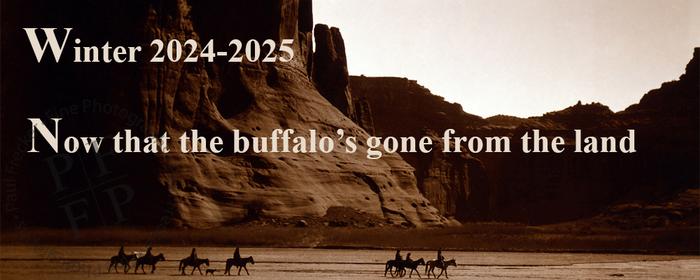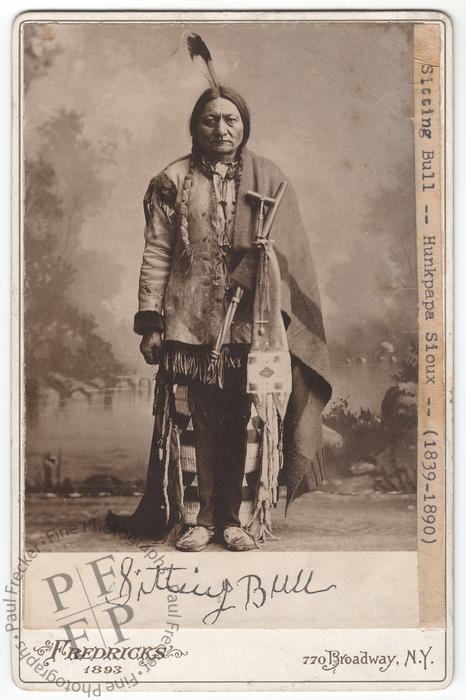
Sitting Bull of the Hunkpapa Lakota, c.1893
C.D. Fredricks of New York
A cabinet card portrait of Sitting Bull of the Hunkpapa Lakota, with a printed facsimile of his signature in the lower margin. A narrow strip of typed text identifying the sitter has been pasted along the right-hand edge of the print; it looks like this was added in the early 20th century. This identifies him as Sitting Bull of the Hunkpapa Sioux. The Sioux are a confederacy of several tribes that speak three different dialects: the Lakota, the Dakota and the Nakota. The Lakota comprises seven tribal bands, one of which is the Hunkpapa.
Sitting Bull’s people, led by Crazy Horse, met with the troops of the 7th Cavalry at the Little Big Horn River on 27 June 1876. During the ensuing battle, General George Armstrong Custer was killed. Sitting Bull and his people subsequently escaped into Canada, where they remained for four years until hunger and desperation forced them to return to the United States and surrender on 19 July 1881.
In 1885 Sitting Bull joined William F. Cody’s (Buffalo Bill’s) Wild West Show, earning $50 a week for simply riding once around the arena in each presentation. He proved a popular attraction, although it is rumoured he cursed his audiences in his native tongue while he smiled and performed for them. He only stayed with the show for four months before returning home.
Back at the Standing Rock Reservation, on the border between North and South Dakota, Sitting Bull became embroiled with the Ghost Dance movement (a quasi-religious resistance movement whose adherents danced to raise the spirits of the dead to fight alongside them), although it is possible that he did no more than allow the dancers to meet on his land. Sitting Bull was fatally shot when he resisted arrest at dawn on the 15 December 1890. His body was buried at Fort Yates in North Dakota but in 1953 was exhumed by members of his Lakota family and buried at his birth place near Mobridge, South Dakota.
Photographed by C.D. Fredricks of New York.
Condition: the print is in excellent condition, with very good tonal range. The mount presents a very small amount of dirt verso but is otherwise also in excellent condition.
Dimensions: the card measures 6.4” by 4.2” (16.4 cm by 10.7 cm)
code: cat001

John Young Nelson and his family, 1887
by Elliott and Fry of London
A cabinet card portrait of the frontiersman, scout, interpreter and guide John Nelson, photographed with his Native American family in London in 1887-1888, while they were appearing with Buffalo Bill’s Wild West Show.
Born in Virginia in 1826, Nelson ran away from home to escape his domineering father and to seek adventure in the West. Along the way he took odd jobs on farms; he also worked as a cabin boy on a Mississippi steamboat and as an apprentice to a group of traders. After meeting a band of Sioux he decided that a nomadic life would suit him better and he got himself adopted into the tribe. As a young Sioux brave he learnt to live off the land and fight like a Sioux warrior, participating in raids and skirmishes. His adopted father was Chief Spotted Tail.
He was married four times in his life, always to Native American women. The woman he is seen with here is his fourth wife, Jenny Nelson (Yellow Oak Woman) with whom he had five children. His first three wives had resented being forced to marry a white man and the marriages had not lasted.
Later Nelson guided Brigham Young and the first group of Mormon pioneers into Salt Lake Valley, he worked as a military scout, he fought in the Indian Wars and he served as a lawman in North Dakota. He also toured with William F. Cody’s ‘Wild West’ show for several years. He died in 1903 and was buried somewhere along his beloved Medicine Creek in southern Nebraska.
Photographed by Elliott and Fry of Baker Street, London. If the mount weren’t trimmed, the studio’s name would appear in the lower margin and below this there would be mention of ‘Buffalo Bill’s Wild West.’ Although the caption claims copyright, I can find no record that the image was ever registered.
Condition: the print, which is a Woodburytype, is in excellent condition, with rich tonal range. The mount is firm and solid, with crisp edges and sharp corners, but it presents some foxing recto in its margins (there’s only a small amount of faint foxing verso) and its upper and lower edges have been trimmed slightly.
Dimensions: the whole card measures 6.1” by 4.2” (15.5 cm by 10.6 cm).
code: cat002
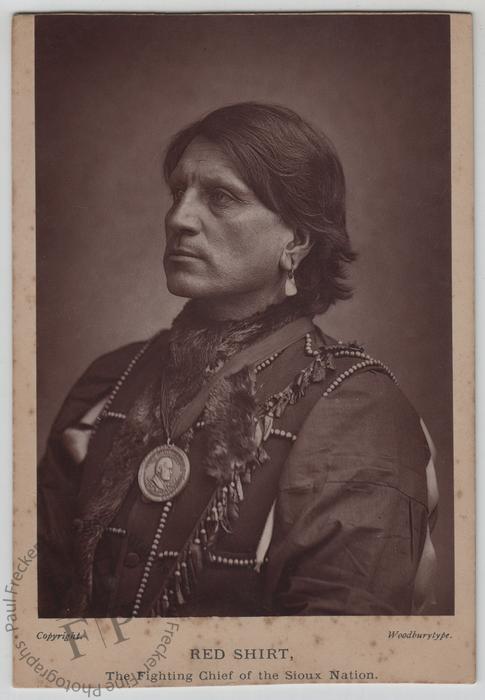
Red Shirt of the Oglala Lakota, 1887
Elliott & Fry of London
A cabinet card portrait of Red Shirt, a chief and statesman of the Oglala Lakota people.
Red Shirt supported Crazy Horse during the Great Sioux War of 1876-1877. After the war he moved to an area in South Dakota now known as Red Shirt. In 1880 he was one of the delegates who visited Washington, D.C. In 1887 he was one of the stars of Buffalo Bill’s (William Cody’s) Wild West Show when it visited England.
Departing New York on 31 March 1887 aboard the SS State of Nebraska, the company included 97 Native Americans, 18 buffalo, 2 deer, 10 elk, 10 mules, 5 Texan steers, 4 donkeys and 108 horses. The Native Americans were well paid and well fed. The tour last five months and visited Birmingham, Salford and London. Queen Victoria, accompanied by Princess Alexandra and Prince Albert Edward, came to see the show during its run at Earl’s Court in London and met some of the cast afterwards. Speaking through an interpreter, Red Shirt expressed his pleasure at meeting the Queen, telling her ‘I have come many thousands of miles to see you. Now that I have seen you, my heart is glad.’ The encounter and his words were widely reported in the press and noted in the Queen's journal.
While in England Red Shirt and his companions also saw Henry Irving’s production of Goethe’s Faust at the Lyceum Theatre (although the Sioux do not believe in Hell) and he also visited Westminster Abbey. In 1889 the show returned to Europe, this time spending six months in Paris. Wild Westing with Cody was Red Shirt’s main source of income for several decades. He died on 4 January 1925 and was buried at Pine Ridge, South Dakota.
Photographed by Elliott & Fry of Baker Street, London.
The caption in the lower margin claims that the photographers had copyrighted the portrait. In fact, the records show that Elliott and Fry only filed for copyright on two of the portraits they took of performers in Buffalo Bill’s Wild West Show, and both of these were portraits of Sergeant Bates, who carried the American flag in the show. These were entered at Stationers’ Hall on 24 June 1887.
Condition: the print is a Woodburytype and is in excellent condition, with very good tonal range. The mount presents some foxing in its lower margin and on its reverse but is otherwise clean and firm. It has been trimmed slightly along its upper and lower edges.
Dimensions: the whole card measures 6.1” ‘by 4.2” (15.5 cm by 10.6 cm).
code: cat003
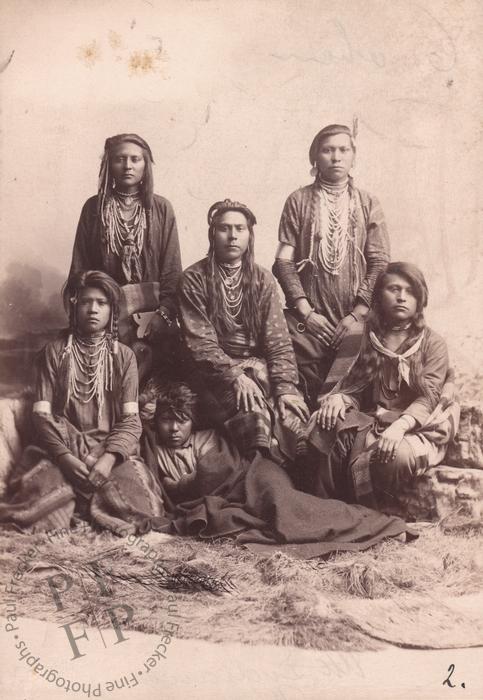
Six Ute people of the Colorado Plateau
C.R. Savage of Salt Lake City
An albumen print portrait of six Ute, an indigenous people of the Great Basin and Colorado Plateau, an area which covers present-day south-east Utah, western Colorado and northern New Mexico. In the past their territory also included parts of Wyoming, Nevada and Arizona. The Ute dialect is a Colorado River Numic language, part of the Uto-Aztecan language family.
Historically the Utes belonged to almost a dozen nomadic bands, who came together for ceremonies and trade. They also traded with neighbouring tribes, including some of the Pueblo peoples.
Although they had limited contact with the Spanish in the 18th century, their first sustained contact with Euro-Americans began in 1847 with the arrival of the Mormons in the American West. The Ute people fought to protect their homelands but in 1864 Brigham Young persuaded Abraham Lincoln to forcibly remove the Utah Utes to a reservation. In 1881 the Colorado Utes were also forced onto a reservation.
Photographed by C.R. Savage of Salt Lake City.
Charles Roscoe Savage is perhaps best remember for his photographs of the coming together of the Union Pacific and the Central Pacific Railroads at Promontory Point in Utah in 1869. Born in Southampton in England in 1832, he emigrated to New York in 1855. Having converted to the Church of Jesus Christ of Latter-day Saints while still a youth in England, he and his family made their way to Salt Lake City, where Charles established a successful photographic studio. He died, aged 76, on 4 February 1909.
Condition: the print presents a small patch of foxing in the area of the background and an inscription recto on the print is showing through slightly in the pale area of the background. The tones of the print, however, are excellent. It is mounted on a slightly grubby album page which is very firm and solid, with crisp edges and sharp corners. An inked inscription verso in German identifies the sitters’ tribe. The number 2 has been inked in the lower right-hand corner of the print.
Dimensions: the print measures 7” by 4.9” (17.8 cm by 12.4 cm); the page on which it’s mounted measures 9.2” by 11.7” (24.5 cm by 29.6 cm).
code: cat004
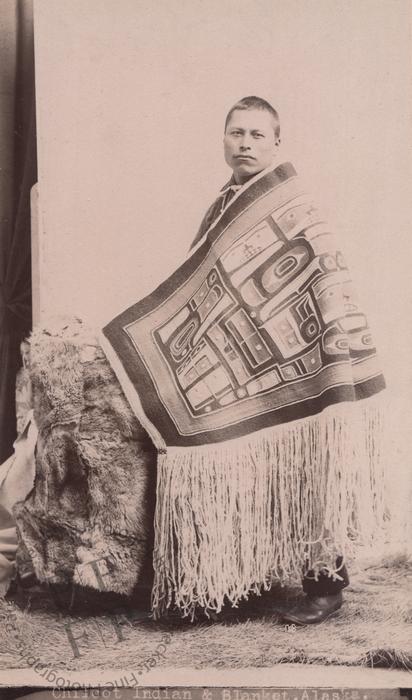
A Tlingit Indian of the Pacific Northwest Coast,
c. 1900-10
Winter & Pond of Juneau, Alaska
A silver print showing a Tlingit Indian beside a pile of furs; he is wearing his traditional Chilkat blanket
The Tlingit are indigenous peoples of the Pacific Northwest Coast; they constitute 2 of the 231 federally recognised Tribes of Alaska. The Tlingit have a matrilineal kinship system, with children born into the mother’s clan, and property and hereditary roles passing through the mother’s line.
Chilkat weaving is a traditional form of weaving practised by Tlingit, Haida, Tsimshian and other Northwest Coast peoples of Alaska and British Colombia. The robes are worn by high-ranking tribal members on civic or ceremonial occasions. The blankets are almost always black, white, yellow and blue. By the 1990s only an estimated six people still practised true Chilkat weaving but today the technique is enjoying a revival.
Photographed by Winter & Pond of Juneau, Alaska.
Established in 1893, the studio was a partnership between Lloyd Valentine Winter (1866-1945) and Edwin Percy Pond (1872-1943). Their work includes scenes of the Klondike Gold Rush, the Tlingit people and views of Alaskan glaciers. The studio was in business for more than fifty years. Pond died in 1943 and in 1945 Winter passed the business on to Francis Harrison, who closed it in 1956.
Condition: the print is in excellent condition, with good tonal range. (The Internet is adding a pinkish hue to the print, at least on my computer, but the original has no pink tones at all.) It is mounted on a very clean, stiff, firm album page with crisp edges and sharp corners. The reverse of the page is blank.
Dimensions: the print measures 7.1” by 4.2” (18 cm by 10.7 cm); the page on which it’s mounted measures 12.7” by 8.9” (32.3 cm by 22.6 cm).
code: cat005
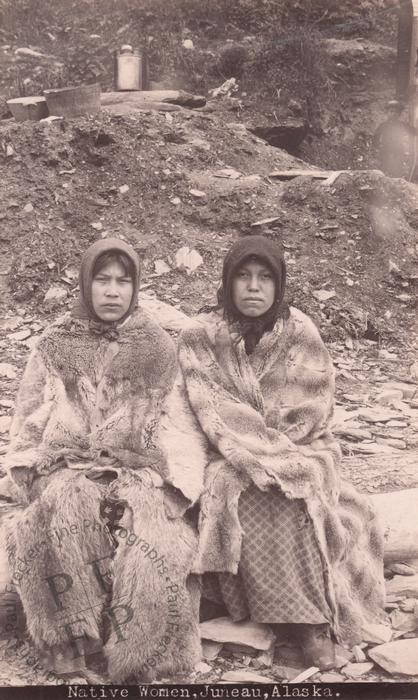
Two Tlinglit Women of the Pacific Northwest Coast,
c.1900-1910
Winter & Pond of Juneau, Alaska
A silver print showing two Tlinglit women in fur cloaks and headscarves. A caption along the lower edge of the print reads only: ‘Native Woman, Juneau, Alaska.’ The Alaska State Library, however, has the same print and have identified the women’s tribe more fully in their online digital archive.
There is also a third figure in the background, perhaps a boy, just below the upper right-hand corner.
The Tlingit have maintained a traditional but complex hunter-gatherer culture based on semi-sedentary management of fisheries. The Coastal Tlingit were divided into three tribes: the Chilkat Tinglilt along the Chilkat River and on Chilkat Peninsula, the Taku Tlingit along the Taku River and the Chilkoot Tlingit. Inland, the Tlingit occupied areas along the major rivers that pierce the Coast Mountains and Saint Elias Mountains.
Photographed by Winter & Pond of Juneau, Alaska.
Established in 1893, the studio was a partnership between Lloyd Valentine Winter (1866-1945) and Edwin Percy Pond (1872-1943). Their work includes scenes of the Klondike Gold Rush, the Tlingit people and views of Alaskan glaciers. The studio was in business for more than fifty years. Pond died in 1943 and in 1945 Winter passed the business on to Francis Harrison, who closed it in 1956.
Condition: the print is in excellent condition, with good tonal range. (The Internet is adding a pale pink hue which is not present in the original.) It is mounted on a very clean, stiff, firm album page with crisp edges and sharp corners. The reverse of the page is blank apart from the inked inscription in German which reads: ‘Amerika, US Alaska.’ (I have another page from the same album where it’s more obvious that the language is German).
Dimensions: the print measures 7.1” by 4.3” (17.9 cm by 10.8 cm); the page on which it’s mounted measures 12.7” by 8.9” (32.3 cm by 22.6 cm).
code: cat006

Wicked Bear of the Brulé Sioux, 1872
Alexander Gardner of Washington, D.C.
Two albumen print portraits of Wicked Bear (Ma-to-tzin-tzi-tsah), a Brulé (Sichangu) Sioux chief who in 1872 was part of a delegation who met with U.S. Government officials in Washington, D.C.
The Brulé were one of the seven branches or bands (sometimes called ‘sub-tribes’) of the Teton (Titonwan) Lakota Sioux nation. They are known as Sichá?gu Oyáte (in Lakota), or ‘Burnt Thighs Nation,’ and so were called Brulé (lit. ‘burnt’) by the French.
Photographed by Alexander Gardner of Washington, D.C.
Born in Paisley in Renfrewshire in 1821, Alexander Gardner was a Scottish newspaper editor who became interested in photography when he visited the Great Exhibition in 1851 and saw the photographs of American Mathew Brady. In 1856 he emigrated to the United States, where he established a successful studio in Washington, D.C. He is best remembered for his portraits of Abraham Lincoln (he photographed the President on seven different occasions), his photographs of the American Civil War (some of which were if not quite staged certainly manipulated), and his photographs of the conspirators in the Lincoln assassination plot (he was the only photographer allowed at their hanging). He was also commissioned to photograph Native Americans who came to Washington to discuss treaties. He gave up photography in the early 1870s, helping to found an insurance company instead. He died at his home in Washington, D.C., on 10 December 1882.
Condition: one of the prints has some small white abrasions at its right-hand edge and some scuff marks in the area of the sitter’s head feather. Apart from that, both prints are in excellent condition, with very good tonal range. They are mounted on sections of crisp, clean card, presumably cut down from album pages. Both mounts have slight abrasion verso along the upper edge where they were mounted with Japanese rice paper in a matte.
Dimensions: one print measure 6.4” by 3.9” (16.2 cm by 9.9 cm); the mounts measure 7.4” by 4.5” (18.8 cm by 11.4 cm). The other measures 6.5” by 3.8” (16.4 cm by 9.7 cm) with a mount measuring 7.6” by 4.5” (19.2 cm by 11.4 cm).
code: cat007
